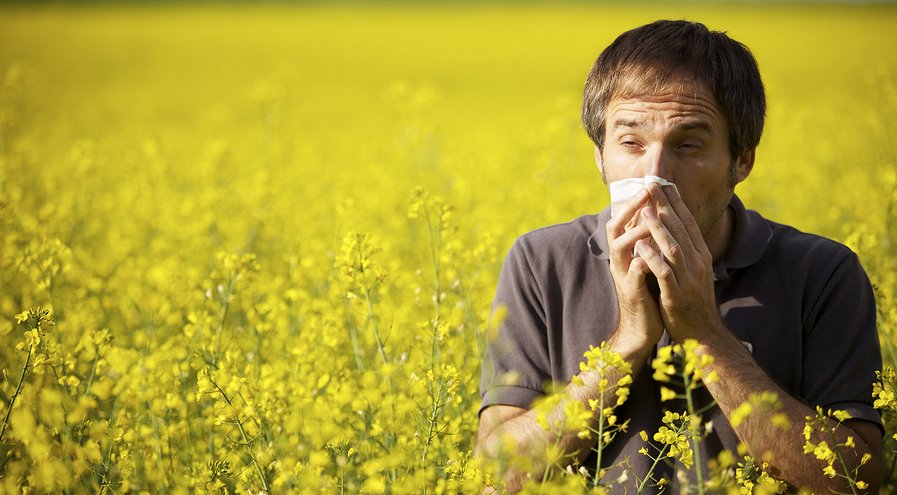In most locations, spring has sprung in all its glory in the last few weeks, with landscapes turning greener and flowers blooming everywhere. As beautiful as that is, especially after the bleakness of winter, it can mean trouble for you if you suffer from seasonal allergies. In fact, you might be noticing that your allergies are worse than usual lately. If that’s the case, you are hardly alone. New research suggests that hay fever has been increasing in recent years.
The study, which was conducted at the University of Maryland in College Park, found that the prevalence of seasonal allergies appears to be on the rise.1Sapkota, Amir; et al. “Associations between alteration in plant phenology and hay fever prevalence among US adults: Implication for changing climate.” PLoS One. 28 March 2019. Accessed 2 April 2019. http://journals.plos.org/plosone/article?id=10.1371/journal.pone.0212010. These results are based on an extensive analysis of springtime start dates around the United States. The researchers collected data from NASA’s Moderate Resolution Imaging Spectroradiometer (MODIS) to pinpoint exactly when trees and plants started to release pollen between 2001 and 2013.
Then, the investigators compared this information to data from the Centers for Disease Control and Prevention (CDC) National Health Interview questionnaire, answered by more than 300,000 individuals living throughout the U.S. during the same time period. They discovered that in regions where spring came earlier than usual, there was a 14 percent greater occurrence of hay fever symptoms. That makes sense since an earlier start to pollen release means a longer allergy season with prolonged pollen exposure.
The more surprising finding, however, was that allergies also increased when spring came later than usual. You might think that a shorter period in which pollen is released would be enough to cut down on the sniffling and sneezing of allergy sufferers, but sadly, that was not the case. In fact, there was the exact same increase of 14 percent in allergy symptoms that sufferers experienced when spring had a later than usual onset. And that happens because a late start contributes to greater quantities of pollen being released during a shorter timeframe, which is just as bad for those with allergies as prolonged exposure.
Why are these fluctuations taking place and wreaking havoc for people with allergies? The researchers note that climate change is likely playing a big role because even slight differences in temperature can affect the life cycle of plants. A fractional degree change can impact the ecosystem in an area and result in either early or late blooming, all of which in turn negatively impacts allergy sufferers. And this is not the first study to suggest that allergies are on the rise, either. A 2006 study conducted by Quest Diagnostics found that the frequency of allergies in the U.S. increased by almost six percent within a four-year timeframe and continues to rise.2Hadley, Caroline. “Food allergies on the rise? Determining the prevalence of food allergies, and how quickly it is increasing is the first step in tackling the problem.” Embo Reports. November 2006. Accessed 4 April 2019. http://www.ncbi.nlm.nih.gov/pmc/articles/PMC1679775/.
Since there is little we can do to prevent these changes beyond reducing our own carbon footprint of course, those with allergies need to take action to protect themselves. Start by paying attention to the pollen forecast and staying indoors during peak hours of 5 AM and 10 AM when the pollen count is highest. Any time you have been outside during allergy season, make sure you wash your hands, shower before going to sleep, and wash the clothes you were wearing to remove traces of pollen. Invest in a high-quality HEPA air filtration system for your home, too, which will remove pollen particles and other irritants from the air.
And, since allergies are ultimately an immune system problem, you also need to do everything possible to optimize your immune system. Immunomodulators can help calm your immune system and prevent it from going into overdrive when exposed to a trigger. But you also want to consider a digestive enzyme formula with your meals to reduce the number of allergens that food puts into your system as well as a good systemic, proteolytic enzyme formula to actually remove allergens already in your bloodstream as well as Circulating Immune Complexes camped out in your body’s soft tissue—all of which will help reduce your body’s susceptibility to springtime’s pollen allergens.
References
| ↑1 | Sapkota, Amir; et al. “Associations between alteration in plant phenology and hay fever prevalence among US adults: Implication for changing climate.” PLoS One. 28 March 2019. Accessed 2 April 2019. http://journals.plos.org/plosone/article?id=10.1371/journal.pone.0212010. |
|---|---|
| ↑2 | Hadley, Caroline. “Food allergies on the rise? Determining the prevalence of food allergies, and how quickly it is increasing is the first step in tackling the problem.” Embo Reports. November 2006. Accessed 4 April 2019. http://www.ncbi.nlm.nih.gov/pmc/articles/PMC1679775/. |











